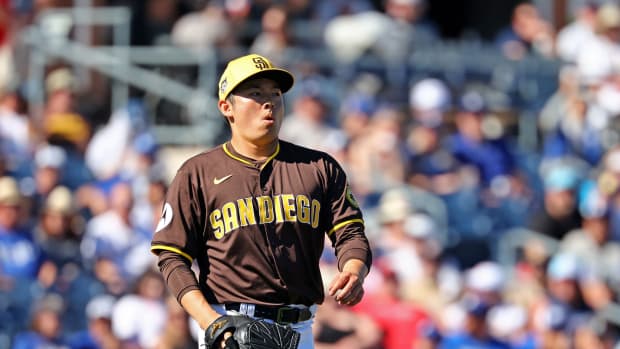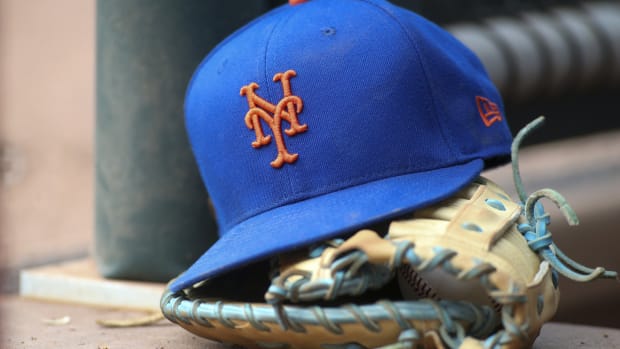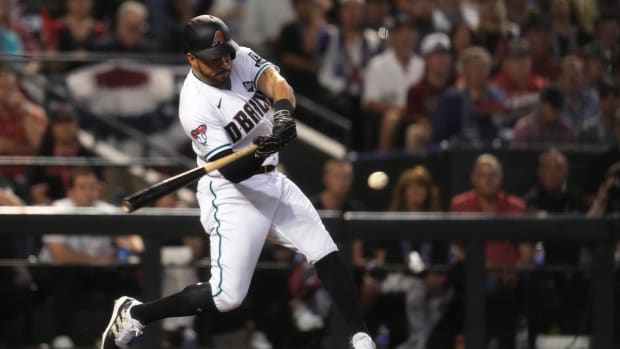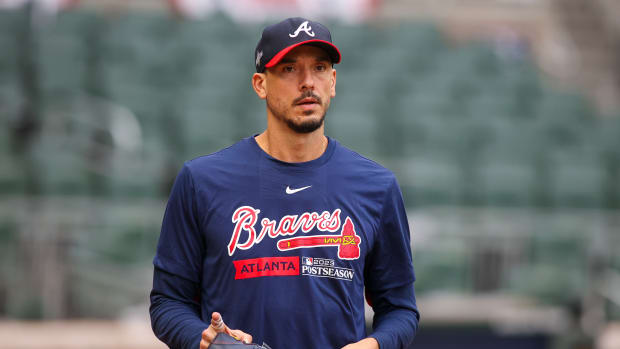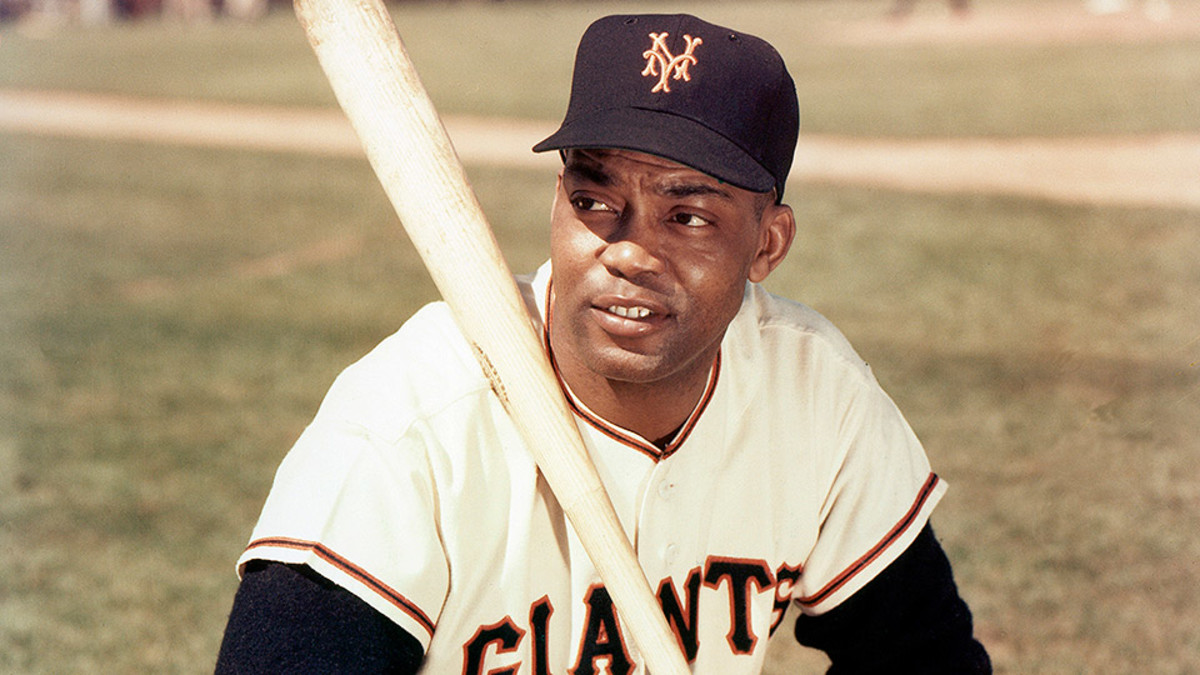
Remembering Monte Irvin, a trailblazer in baseball’s integration
On Monday night, the baseball world lost a giant with the passing of Hall of Fame outfielder Monte Irvin at age 96. A key figure in the integration of the major leagues, Irvin nearly beat Jackie Robinson across the color line before going on to star for two New York Giants pennant winners, and later served as baseball’s first black executive and a key figure in the Hall’s recognition of Negro League stars. He had been living in a retirement home in Houston, and prior to his death was the second-oldest living Hall of Famer, behind only Bobby Doerr.
A four-time participant in the Negro leagues’ East-West All-Star Game (1941 and 1946–1948), Irvin spent seven seasons with the Giants (1949–1955) and one with the Cubs, all after turning 30. He finished his major league career with 99 homers and a .293/.383/.475/125 OPS+ batting line, numbers that represent only the tip of the iceberg given what his immense talent might have yielded in a full career that included his prime years. He was elected to the Hall of Fame in 1973, and had his uniform number 20 retired by the Giants in June 2010.
Hall of Famer Roy Campanella, who played against Irvin in the Negro National League as well as the majors, said upon the occasion of his longtime rival’s election, “Monte was the best all-around player I have ever seen... There wasn’t anything Monte couldn’t do and there wasn't any position he couldn’t play. He was one of the fastest men for his size I ever saw and what most people don't know is what a tremendous arm he had. Oh, what an arm. He threw nothing but strikes.”
One of 11 children born to a sharecropper’s family in Haleburg, Ala., in 1919, Irvin grew up in Orange, N.J., where he starred in four sports (baseball, football, basketball and track) in high school, earning a total of 16 letters, setting a state record for the javelin and overcoming a near-fatal hemolytic streptococcus infection resulting from a cut on his hand as a senior. Even in New Jersey, he felt the sting of racism. On the night of his high school graduation, he and three friends were turned away from a restaurant where they had gone to celebrate. “You’re in a democracy and you go to school and the teacher is drilling into you about fair play and the moment you get out of school they discriminate against you. What the hell kind of system is that?” he recalled in a 1988 interview. “So instead of really celebrating we just went on home and went to sleep because we felt so terrible about it."
Hall of Famer Monte Irvin passes away at the age of 96
Though he was offered a football scholarship to the University of Michigan, Irvin declined because he didn’t have the money for train fare. Instead, he accepted a football scholarship to Lincoln University, a black college in Oxford, Pa., but he left after two years there due to frustration over his inability to maintain his athletic scholarship while studying along a pre-dentistry track. Pursued by multiple teams, he signed with the Newark Eagles of the Negro National League in 1938, initially playing as “Jimmy Nelson” in road games and avoiding play at home, where he could be easily recognized, in an attempt to preserve his amateur standing. He presented himself to player-manager Willie Wells as a shortstop, only to be told to try the outfield, since shortstop was Wells’ position. He became a regular in 1939 and hit for a .365 average, fourth in the league, boosted that to .383 (second in the league) the following year, and then to .382 (third in the league) in 1941, accompanied by nine homers (tied for the league lead).
Rebuffed after asking Eagles owners Abe and Effa Manley for a $25-per-month raise, he spent 1942 in the Mexican League, where he won the Triple Crown and league MVP honors via a .397 batting average, 20 homers and 79 RBI in just 63 games. Drafted by the Army in 1942, he spent three years with the GS Engineers 1313th Battalion, helping to build infrastructure in Europe. In 1944, his unit was deployed to the secondary line during the “Battle of the Bulge.”
When Irvin returned from the war, Dodgers general manager Branch Rickey tried to sign him to become the player who would break the majors’ color line. “Monte was the choice of all Negro National and American League club owners to serve as the No. 1 player to join a white major league team,” said Effa Manley before her death in 1981. “We all agreed, in meeting, he was the best qualified by temperament, character ability, sense of loyalty, morals, age, experiences and physique to represent us as the first black player to enter the white majors since the Walker brothers back in the 1880s.”
The owners weren’t alone in viewing Irvin as a potential pioneer. In an interview for the 1982 book Baseball for the Love of It by Anthony J. Connor, Hall of Famer Cool Papa Bell said of Irvin, “Most of the black ballplayers thought Monte Irvin should have been the first black in the major leagues. Monte was our best young ball player at the time. He could hit that long ball; he had a great arm; he could field; he could run. Yes, he could do everything.”
SI Vault: The Breakthrough: Why May 1947 was crucial for Jackie Robinson
Irvin, however, didn't feel he was in good enough shape given his military stint. “I had three years of athletic rust and a bad case of war nerves,” he later said. What’s more, Rickey was unwilling to pay the Eagles for his rights, as he had done in signing Don Newcombe. Irvin didn’t lament passing up the opportunity, saying in 2010 “I don’t have any regrets. I couldn't aspire to becoming a Major Leaguer because the door was closed. Jackie Robinson is the real hero and the real pioneer. I was just so happy he was successful, and it made it much easier for all of us who came after him.”
Irvin returned to Newark, playing shortstop alongside second baseman Larry Doby, who in 1947 would break the American League color line with the Indians. In addition to winning the league batting title with a .401 average in 1946, Irvin hit .462 with three homers while helping the Eagles beat the Kansas City Monarchs in the Negro League World Series. He shifted back to the outfield the following year, and played for Newark through 1948 before being sold to the Giants for a mere $5,000.
Now 30 years old, Irvin began the 1949 season with the team’s International League affiliate in Jersey City, hitting a sizzling .373/.519/.642 in 63 games. The Giants recalled him; on July 8 against the Dodgers, manager Leo Durocher started former Monarchs star Hank Thompson, who had debuted with the St. Louis Browns in 1947, at second base, and used Irvin as a pinch-hitter in the eighth inning, making them the second NL team to integrate after the Dodgers. Though he drew a walk in that debut, Irvin hit just .224/.366/.316 in 93 plate appearances while playing sporadically. He returned to Jersey City to start the 1950 season but was back in the majors by mid-May, and hit .299/.392/.497 with 15 homers and 3.5 WAR in 432 PA while splitting his time between first base and the outfield corners.
The 1951 season was the best and most important of Irvin’s career. He hit .312/.415/.514 with 24 homers and a league-high 121 RBI, numbers that were good for a third-place finish in the NL MVP voting. His slash stats all ranked among the league's top 10, while his 6.9 WAR ranked fourth. From Aug. 11—the point at which the Giants trailed the Dodgers by 13 1/2 games—to the end of the season, he hit .330/.416/.602 with 10 homers in 47 games. “I don’t think there ever was a better hitter than Irvin was the last two months,” recounted Hall of Famer Carl Hubbell, at the time the director of the Giants’ farm system, upon the occasion of Irvin’s election. In the final game of the tiebreaker series with the Dodgers, Irvin did make the Giants’ lone out in the ninth inning before Bobby Thomson hit the pennant-winning, three-run “Shot Heard ‘Round the World” home run. He would later joke, “Now I prefer to tell people I set the stage by not hitting into a double play.”
Irvin went on to collect a World Series-high 11 hits in the Giants’ six-game loss to the Yankees; he tripled and stole home off Allie Reynolds in Game 1. His biggest impact, however, may have been serving as a mentor to 20-year-old rookie Willie Mays, who joined the team in late May.
“In my time, when I was coming up, you had to have some kind of guidance. And Monte was like my brother,” Mays told MLB.com’s Chris Haft in 2012. “I couldn’t go anywhere without him, especially on the road... It was just a treat to be around him. I didn’t understand life in New York until I met Monte. He knew everything about what was going on and he protected me dearly.”
Unfortunately, Irvin broke his right ankle sliding into third base during an exhibition game in April 1952. He played in just 46 games, though he was named to the NL All-Star team for the only time in his career. He rebounded to hit .329/.406/.541 with 20 homers, 97 RBI and 4.4 WAR in 1953, but was plagued by back problems resulting from favoring his bad leg upon returning from the injury. Though he helped the Giants win the NL pennant and beat the Indians in the World Series in 1954, the 35-year-old slugger’s numbers took a downturn (.262/.363/.438 with 19 homers). Fifty-one games into the 1955 season, he was sold to the Triple A Minneapolis Millers of the American Association. He returned to the majors with the Cubs in 1956, hitting .271/.346/.460 with 15 homers in 388 PA. After playing four games with the Pacific Coast League's Los Angeles Angels in 1957, he was forced to retire due to a back injury suffered in spring training.
Upon retirement, Irvin continued to work as a community relations director for Rheingold Brewery, a job he had begun in 1951, at the height of his playing career. He remained in that capacity until 1968, and scouted for the Mets in 1967–68 as well. In 1968, Commissioner Spike Eckert hired him in the newly-created position of assistant director of promotion and public relations, a job he continued to do through successor Bowie Kuhn’s 1969–1984 tenure as commissioner.
In 1971, Kuhn and Hall of Fame president Paul Kerr named him to chair the Hall of Fame’s Special Committee on the Negro League, the beginning of the institution’s belated efforts to recognize the cream of the crop whom the color line kept out of the majors (it took a showdown between Kuhn and Kerr for the honorees to be granted equal status, with plaques in the same spot as those elected for their time in the majors). Irvin and the committee elected Satchel Paige in 1971, then Josh Gibson and Buck Leonard in 1972. The next year, he himself was elected, with Bell (1974), Judy Johnson (1975), Oscar Charleston (1976), Pop Lloyd (1976) and Martin Dihigo (1977) following before the committee voted to disband in 1977, with the Veterans Committee taking over its duties in considering Negro League players.
“I’m just sorry I didn’t get a chance to make the majors at 18 or 19 like Willie Mays and Henry Aaron,” said Irvin upon being elected. “I would have liked to play 18 or 19 or 20 years in the majors. I was way past my peak when I got the chance. But there’s not point in reminiscing or being bitter. I’m just grateful to have played seven [sic] years.”
• SI VAULT: The private world of the Negro ballplayer
At his induction ceremony, Irvin began his acceptance speech with an apology, “I’d rather face Warren Spahn than make a speech, so I beg your indulgence… I hope my induction will help to ease the pain of all of those players who never got a chance to play in the majors.” In addition to that honor, Irvin was elected to Mexico’s Salón de la Fama in 1971, and, in recognition of his playing in the Cuban Winter League, to the Cuban Baseball Hall of Fame in 1997.
Irvin remained with the commissioner’s office after Kuhn’s departure, handling various special assignments. In Kuhn’s stead, he attended the April 8, 1974 game in which Aaron broke Babe Ruth’s all-time home run record; Kuhn’s lack of attendance rankled Aaron for years.
Irvin maintained ties with the Giants, who in 2010 retired his number and then invited him to throw out the first pitch of Game 1 of the World Series. After they won for the third time in five years in 2014, they took him with them on their White House visit to meet President Barack Obama. “I am particularly honored to have a couple of trailblazing Hall of Famers here,” said the president of Irvin and Mays.
In a statement released by the Giants on Tuesday, Mays remembered his friend and mentor:
“Today is a sad, sad day for me. I lost someone I cared about and admired very, very much; someone who was like a second father to me. Monte was a kind of guy that you had to be around to get to know. But once you became friends, he always had your back. You had a friend for life. Monte Irvin was a great left fielder. Monte Irvin was a great man. I will miss him. There are no words for how I feel today. I could say so much more about Monte, but this is not so easy to do right now.”
In a statement released by the Hall of Fame, president Jeff Idelson praised Irvin’s career, his personality, and his pivotal role with the institution:
“Monte Irvin’s affable demeanor, strong constitution and coolness under pressure helped guide baseball through desegregation and set a standard for American culture. His abilities on the field as the consummate teammate are undeniable, as evidenced by World Series titles he contributed to in both the Negro and Major leagues, and a richly deserved plaque in Cooperstown. He was on the original committee that elected Negro League stars to the Hall of Fame, something for which the Museum will always be grateful.”
Both on and off the field, Monte Irvin was a giant in the baseball world.






























